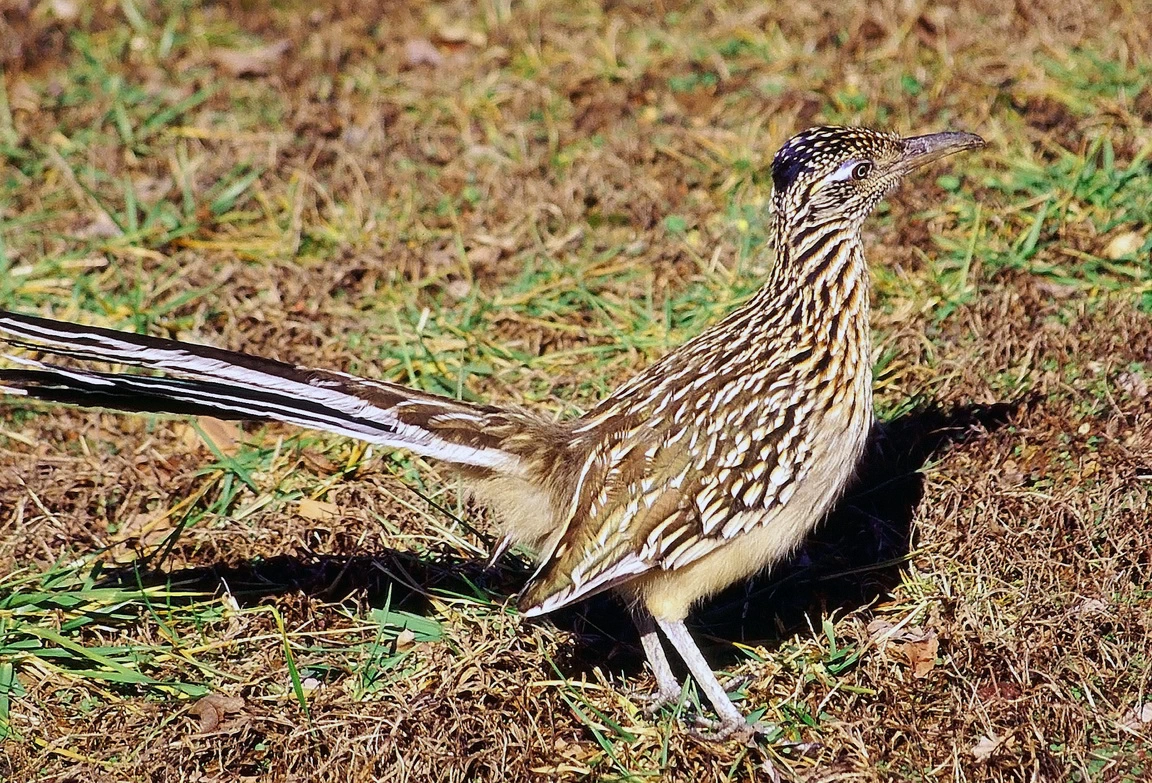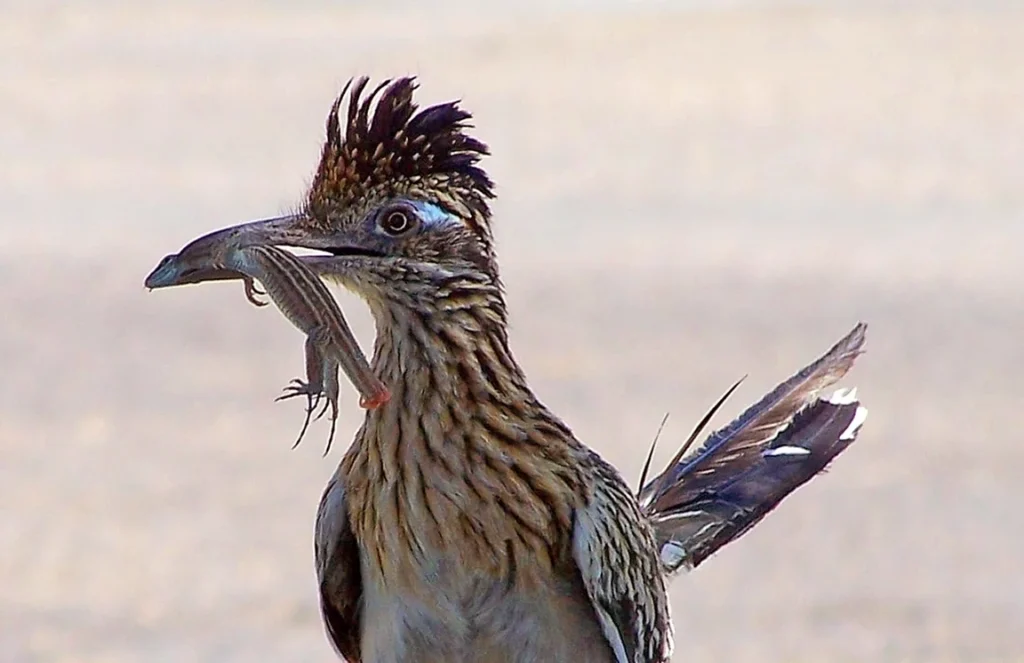

If you think Arkansas is too lush for a roadrunner, think again. These zippy birds, synonymous with the deserts of the Southwest, have found a home right here in the Natural State.
Many of you might say you’ve never seen one, but the greater roadrunner, as it’s formally known, lives throughout much of Arkansas, from the edges of Ozark Mountain woodlands to the bayou bottoms of the Delta. Watch closely as you travel, and you just might spot this relentless bundle of energy zipping along the ground, chasing lizards, insects and small snakes.
In the old days, cowboys were amused by the bird’s habit of racing ahead of their horses, which earned it the name “roadrunner.” Mexicans of Sonora affectionately call it “paisano,” or countryman.
Range Expansion
Once limited to the desert Southwest and Mexico, the roadrunner expanded its range north and east throughout the 20th century—reaching California, Kansas, Oklahoma, and eventually across the Ozark Mountains into the Mississippi River basin. Biologists believe that land clearing, overgrazing and the regrowth of scrub habitat allowed the bird to make its eastern invasion.
The roadrunner’s swift expansion in Arkansas speaks to its adaptability. First reported in the state’s southwest corner in 1936, the bird quickly spread. By the 1940s, there were sightings in central Arkansas. In the 1960s, it crossed the Ozarks, reaching the flat agricultural lands beyond. By the 1970s, the species had settled in the state’s eastern lowlands, far from where it was first documented.
Behaviors
Unlike other members of the cuckoo family, roadrunners are ground-dwellers, rarely taking flight. They sometimes glide short distances or leap into the air to catch insects on the wing, but mostly, they run. Their long, powerful legs allow them to reach speeds of 15 miles per hour or more, with their foot-long tail acting as a rudder to help them change direction or stop.
The roadrunner’s appetite is enormous, and it will eat almost anything that moves. Insects, scorpions, centipedes, spiders, toads, lizards, small snakes, birds, eggs, mice and even roadkill all make it onto the roadrunner’s menu. Some claim that the blue skin patch around the bird’s eye attracts hummingbirds, making them easy prey for the roadrunner to snatch out of the sky.

In early spring, food items often play a part in roadrunner courtship. Males will dash behind females with a tempting lizard or snake dangling from their bills, wagging their cocked tails to get attention. If the female accepts the offering, the pair usually mates, reaffirming their bond for another season.
Legends & More
Like many unusual animals, roadrunners are the subject of countless legends. Some say they kill rattlesnakes by surrounding them with a circle of cactus spines or small stones to keep the snake from escaping. But this spectacle has never been witnessed by any professional naturalists and is always described as something “a friend of a friend” saw.
It’s not just the legends that make the roadrunner fascinating—sometimes the real-life antics are just as amazing. Take the bird I observed while visiting my friend Cliff in the Ozarks. Cliff had told me about the antics of this roadrunner that lived on his property, often fighting its reflection in the windows or mirrors of his home. One morning, we spotted it sitting near the house with its wings spread wide and its feathers fluffed out. A patch of black skin on its back was exposed to the sun.
“It’s just sunning itself,” Cliff said. “It does that every day. Wait a bit, and it’ll be racing around just like a roadrunner is supposed to do.”
Sure enough, after about 30 minutes in the sun, the bird smoothed its feathers and began darting after insects and small reptiles. I later learned this sunning behavior helps roadrunners regulate their body temperature. Their normal temperature is around 101 degrees Fahrenheit, but during a cold night, it can drop by as much as seven degrees. In the morning, they expose dark patches of skin to the sun, warming their blood and saving energy.
Crazy Calls
Even their call is unique and has left naturalists searching for the right words to describe it. Naturalist Joseph Wood Krutch tried to describe it in his 1971 book The What and the Why of Desert Country. He wrote: “The sound which he makes is like nothing on earth, least of all like a bird. One writer describes it as a sort of modified Bronx cheer… it seems to be made by the raucous expelling of air accompanied by the rapid gnashing of the bill—if a bill can be gnashed. Like the bird himself, the sound is derisive, irascible, ribald, threatening and highly self-confident.”
I couldn’t describe it better.
There’s something indescribably comic about the roadrunner, and as Krutch notes, “comic rascals have a way of engaging the affection of even the virtuous.” Nearly everyone who sees a roadrunner can’t help but smile.
Next time you’re driving through Arkansas, keep your eyes peeled. You might just catch a glimpse of this comic rascal, zipping through the brush with a swagger that never fails to bring a smile.
P.S. You can use this link to share this post: https://downhomearkansas.net/cool-facts-about-arkansas-roadrunners.

Keith “Catfish” Sutton of Alexander, Arkansas, is one of the country’s best-known outdoor
journalists. His stories and photographs about fishing, hunting, wildlife and conservation have
been read by millions in hundreds of books, magazines, newspapers and websites. He and his
wife Theresa own C&C Outdoor Productions Inc., an Arkansas-based writing, photography,
lecturing and editorial service.




Get DownHome Arkansas blog posts, news, and more directly by email. Give us your name and email if you’d like to subscribe.
2 Responses
Great article on roadrunners in Arkansas. We had had a pair for two years around our place. They are definitely part of our morning coffee club. They are a great subject for conversation and reading. Thanks for your time and keep up the outdoors articles.
Great article.